Updated: 30-Jan-2018
It was through the union of two personages that this brand emerged around 1893 and two years later a motorized tricycle with a single-cylinder engine appeared, which we will see below.
-The noble De Dion joined the capable inventor Bouton for this work and this success was followed by a number of engines that were adapted to aviation. Thanks to the use that Santos Dumont made of this engine modifying it and use it in its dirigible No 1. (See Santos Dumont).
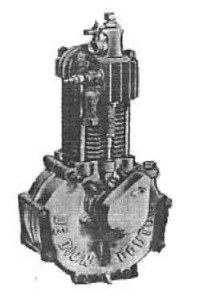
"De Dion-Bouton single-cylinder engine"
-Investigating this brand, we have located some engines in Paris.
-A single-cylinder DeDion Bouton at the Museum Les Arts et Metiers, exhibited in a showcase.

"DeDion-Bouton single-cylinder engine"
-It is air cooled and it is the engine that Santos Dumont used on his airships in a strange double assembly, with one cylinder on top of the other. He joined the two pistons by a rigid piston rod.

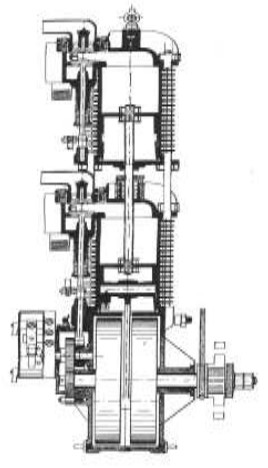
"Engine modified by Santos Dumont"
-The engine used by Santos Dumont was brilliantly modified.
-To reach this solution he had to use a lot of imagination.
-It is the single-cylinder engine fitted with another cylinder on top and both pistons joined in tandem with a piston rod.
-The upper one of the two pictures above shows Santos on the Nacelle with such an assembly. The lower one is a drawing of this engine.
-Shortly before that experience, De Dion-Bouton tried out star engines like the four-cylinder rotary shown below, with a kind of fragile appearance and with the cylinders strutted with braces from each cylinder head.
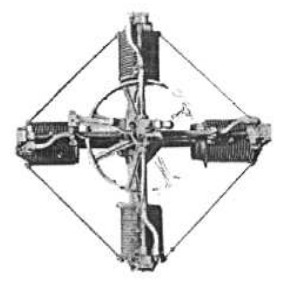
"Rotary radial engine"
-And also a stationary 12-cylinder radial that is shown below.

"De Dion-Bouton logo"

"Stationary radial 12-cylinder engine"
-During the 1909 Paris Air Show a large water-cooled, 8-cylinder, V-engine was shown. It was meant to be used in airships. With 80-100 CV it was heavy for its power, but an interesting engine in the end. The obtained photograph is more defined with respect to the previous edition of 2003.
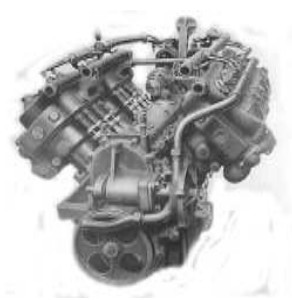
“De Dion-Bouton, water-cooled V8”
-Extending the chapter of this brand we have located a side view of the water-cooled, eight-cylinder engine that gave 80-100 CV.
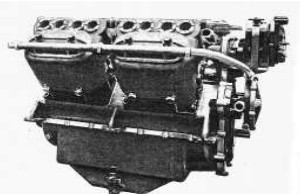
"Side view of the same V8"
-Remember that this beautiful piece of mechanic could already be seen at the 1909 Paris Airshow.
-There was the series of air-cooled 8-cylinder engines in V of 90° that gave 70 to 130 CV.

"80 CV, air cooled"
-The 80 CV is shown with the rear fan but without the fairing that is shown in the next 100 CV.
-It is very similar to the eight-cylinder Renault V-engine in its general appearance and comparison is irresistible here. Even its inner parts, without being exact, are very similar.
-We show it for the two engine brands in the following schematic diagrams: the De Dion-Bouton and the Renault.
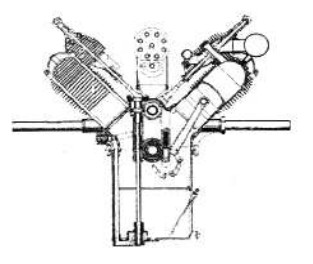
"De Dion-Bouton"
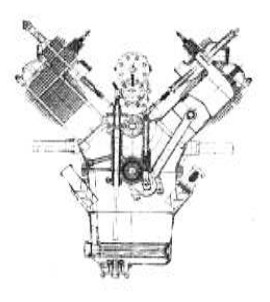
“Renault”
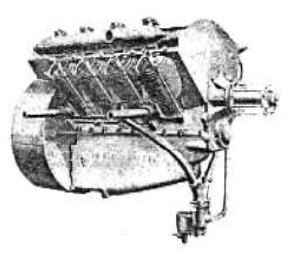
"De Dion-Bouton, 100 CV"
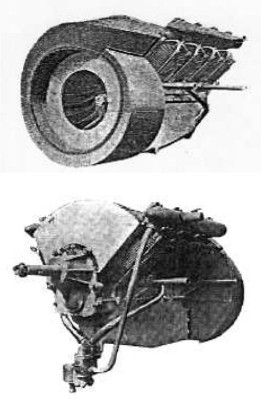
"De Dion-Bouton 100 CV"
-The 12-cylinder, 130 CV V-engine with the side fairing installed is shown in the photograph and below it the schematic diagram with the cylinders in sight. From 1916.
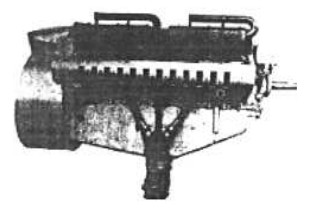
"De Dion-Bouton 130 CV"

"The 130 CV engine schematic diagram"
-As from 1915, the 150 CV V-8 engines are water cooled.
-The 800 CV with 16 cylinders in X appears in full WWI, with 4 rows of 4 cylinders forming the cross at 90 °.
-It weighed 1,900 lbs.

"De Dion-Bouton double V"
-The 16-cylinder engine with four rows of four cylinders delivered 800 CV at 1,300 rpm direct to the propeller.

"DeDion, 800 CV"
-This immense engine has been located in the Reserve Store at the Paris Air Museum.
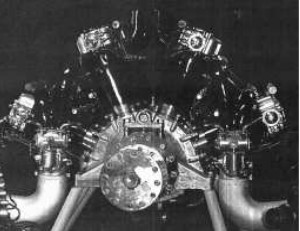
“De Dion-Bouton, at the MAE”
-Towards 1922 the De Dion-Bouton with two groups of cylinders in V appeared. It gave 900 CV at 1,430 rpm, had a displacement of 69 liters and it had several singularities: it had 4 rows of cylinders but the master rods were in the inner cylinder rows only.
-See engine schematic diagram above. Rather cornered at the MAE you can see the engine of the photo.
-We add three more views of the engine at the Air and Space Museum of Le Bourget, in Paris.
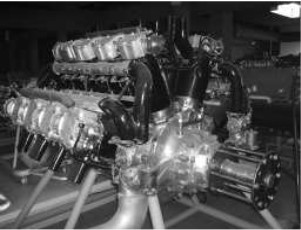

-Two important air intakes feed two carburetors and each of these feed two cylinder rows.
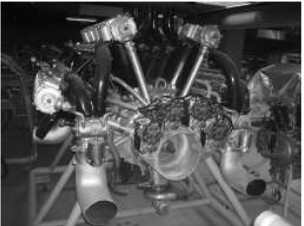
"16-cylinder rear view"
-In this previous picture we see the four magnetos. One for each cylinder row.
From Appendix 7: Contribution of Mr. Birch from AEHS with a photograph (Flight) of the 100 CV DeDion-Bouton, an 8-cylinder engine in V with blocks at an angle of 90 °.
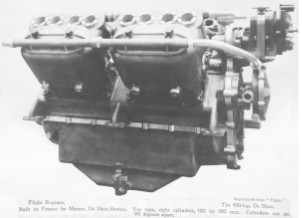
"DeDion-Bouton 100CV engine"
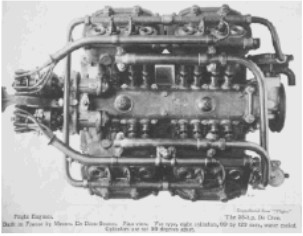
"DeDion-Bouton, 35 CV"
-From the same source, the 35 CV engine in top view. Although it has two magnetos it has not double ignition but each magneto feeds a cylinder row. Cylinders of 90 x 120 mm.
-New pictures of this brand's single-cylinder engine in air-cooled and water-cooled versions.

"Two versions of the single-cylinder"

"Advertisement in the Spanish press"
-Installed on the Farman MF-7 in 1915. It gave 80 CV.
Engines of DE DION - BOUTON
Model: 1 cyl. upright, air
Arquitecture: Single-cylinder
Cooling: Air
Total Displacement: Unknown
Bore / Stroke: Unknown x Unknown
Power: Unknown
Weight:

"De Dion-Bouton single-cylinder"
Model: 12 cyl. radial stationary
Arquitecture: 12-cylinder Radial
Cooling:
Total Displacement: Unknown
Bore / Stroke: Unknown x Unknown
Power: Unknown
Weight:

"De Dion-Bouton 12-cyl. stationary radial"
Model: 16 double V, 800 HP
Arquitecture: 16-cylinder V-Engine
Cooling:
Total Displacement: Unknown
Bore / Stroke: Unknown x Unknown
Power: 800 CV
Weight:

"De Dion-Bouton, at the MAE fig2"
Model: 16X, 800 HP
Arquitecture: 16-cylinder X-engine
Cooling:
Total Displacement: Unknown
Bore / Stroke: Unknown x Unknown
Power: 800 CV
Weight:
Model: 2 cyl. upright tandem (Mod. Santos Dumont)
Arquitecture:
Cooling:
Total Displacement: Unknown
Bore / Stroke: Unknown x Unknown
Power: Unknown
Weight:
Model: 4 cyl. radial rotary
Arquitecture: 4-cylinder Rotary
Cooling: Air
Total Displacement: Unknown
Bore / Stroke: Unknown x Unknown
Power: Unknown
Weight:

"De Dion-Bouton, Rotary radial engine"
Model: 8V, 100 CV, air
Arquitecture: 8-cylinder V-Engine
Cooling: Air
Total Displacement: Unknown
Bore / Stroke: Unknown x Unknown
Power: 100 CV
Weight:

"De Dion-Bouton, air-cooled 8V engine"
Model: 8V, 150 HP
Arquitecture: V-Engine
Cooling:
Total Displacement: Unknown
Bore / Stroke: Unknown x Unknown
Power: 150 CV
Weight:
Model: 8V, 70-130 HP, water
Arquitecture: 8-cylinder V-Engine
Cooling: Liquid
Total Displacement: Unknown
Bore / Stroke: Unknown x Unknown
Power: 70-130 CV
Weight:

"De Dion-Bouton, 130 CV"
Model: 8V, 89-100 HP, water
Arquitecture: 8-cylinder V-Engine
Cooling: Liquid
Total Displacement: Unknown
Bore / Stroke: Unknown x Unknown
Power: 80-100 CV
Weight:

"DeDion-Bouton's 100 CV engine"


